
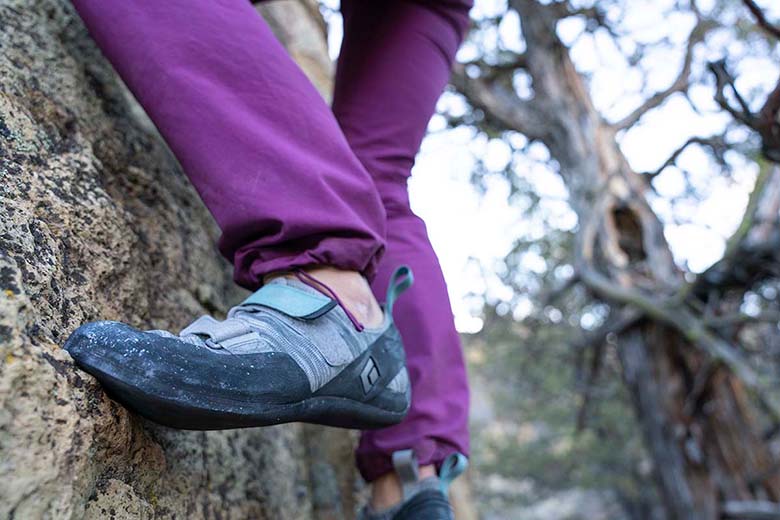
Whether you’re cutting your climbing teeth outside or in the gym, the last thing you want to spend your time worrying about is your shoes. That’s why we’ve taken the time to write this article: Not only does it give beginners a plethora of excellent climbing shoe options, but it answers some very important questions that you may have. From sizing, materials, price considerations, and transitioning into more advanced disciplines, our comparison table and buying advice cover everything you need to know to get shoes on your feet and get you on the wall. If you want to delve deeper into shoe types and what they're best for, check out our article on how to choose the right pair. You can also read about our testing process below the picks. Below are our picks for the 14 best beginner climbing shoes of 2025, but if you’re ready to take the next step, check out our article on the best overall climbing shoes.
Editor's note: We updated this guide on September 7, 2025, to add the Evolv Rave to our list as another slip-on option with a snugger heel fit than the Unparallel UpMocc. We also updated the reviews of the Evolv Defy and Black Diamond Momentum to address recent updates. Lastly, we ensured all other information was up to date at the time of publishing and refreshed the guide with some new imagery from testing.
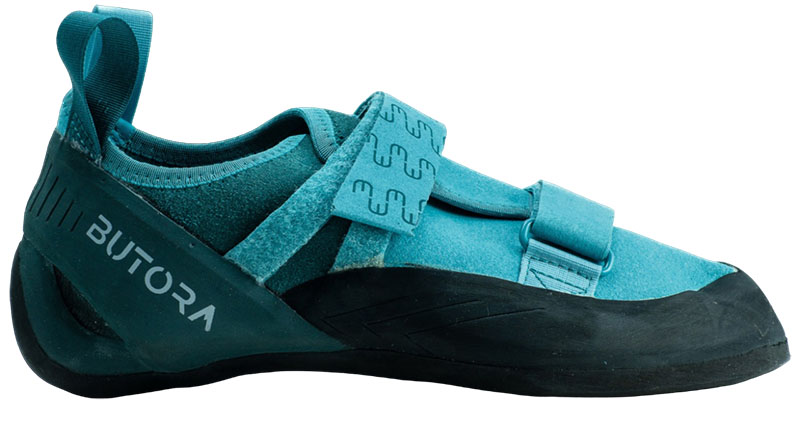 Upper: Synthetic
Upper: Synthetic
Closure: Velcro
Ability level: Beginner to intermediate
What we like: Great price for a well-designed and well-built shoe.
What we don't: Moderate downturn means this shoe won’t excel on overhanging terrain.
Butora might not be as big a name as Scarpa or La Sportiva, but the Korean-born company has established itself as an important player in the U.S. climbing shoe market. Before launching the brand in 2014, shoe designer Nam Hee Do was in the business for over 30 years (most notably, he worked with Chris Sharma to design the Shaman), so it comes as no surprise that Butora’s shoes display an impressive attention to detail and use top-notch materials. The Endeavor 2.0 is their premium entry-level design, and with decent performance, a high level of comfort, and a relatively low price tag, it has secured its place as our favorite beginner shoe of 2025.
Compared to the many true beginner shoes, the Endeavor 2.0 features a slightly downturned shape and very sticky rubber (Butora uses the same Neo Fuse on their high-end models), both of which leave room for progression and reward precise footwork. It’s also available in two widths and half sizes from 34 to 49, so most climbers should find a comfortable fit. But while it’s a wonderful shoe for brand-new gym climbers (especially those learning on ropes) and slabby outdoor climbing, it’s not our top pick for most gym bouldering or steep outdoor terrain. We also don’t love Velcro shoes for crack climbing, since the straps can create painful pressure points and might come undone while jamming. But the Endeavor 2.0 nevertheless strikes an excellent balance for those who prioritize price, performance, and comfort.
See the Butora Endeavor 2.0 Wide Fit See the Butora Endeavor 2.0 Narrow Fit
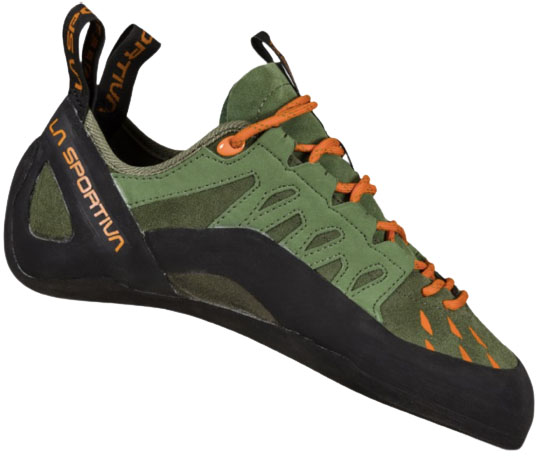 Upper: Leather
Upper: Leather
Closure: Lace
Ability level: Beginner
What we like: Comfort-oriented, durable, and very affordable.
What we don’t: Roomy fit lacks precision; FriXion rubber isn’t particularly sticky.
When shopping for your first shoe, most beginner climbers will want to prioritize factors like affordability, durability, and comfort over outright performance. And for good reason: Proper footwork takes time to learn, and you’ll burn through a lot of rubber in the process. If this sounds like you, the Tarantulace puts it together better than most, with a bargain-basement price tag alongside all the features beginner climbers need. You get 5 millimeters of stiff and durable FriXion rubber, a long-lasting leather upper that will conform to your feet over time, and a roomy toe box that maximizes comfort. Although it’s been around forever, the Tarantulace is far from outdated: La Sportiva gave their beginner model some love in their most recent update, with new aesthetics and colorways along with small changes in design.
Build-wise, the Tarantulace is closer to an approach shoe than most models on this list, with a thick outsole, fairly symmetrical toe, and flat, wide last. In other words, it’s a great combination for all-day comfort (think moderate multi-pitch routes or long gym sessions) but not ideal for steep or particularly technical climbing. For quick learners or those primarily interested in bouldering, La Sportiva also makes the Tarantula Boulder, which features a softer build and higher-performance toe and heel for better hooking capabilities. But if you’re a new climber looking for a comfortable, no-frills shoe, it’s hard to beat the Tarantulace’s price point. In addition to the Tarantula Boulder, the design is also available in a simpler Velcro version (the Tarantula), which offers a similar feel to the lace-up model here.
See the Men's La Sportiva Tarantulace See the Women's La Sportiva Tarantulace
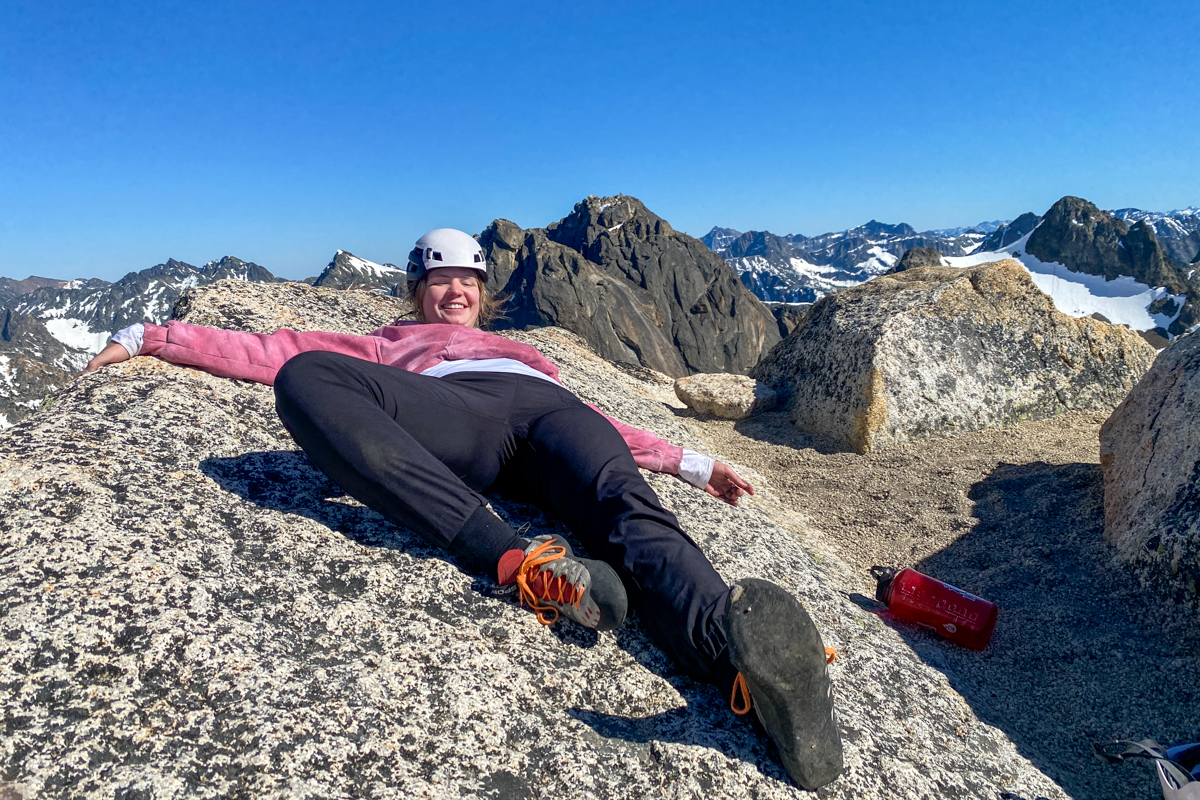
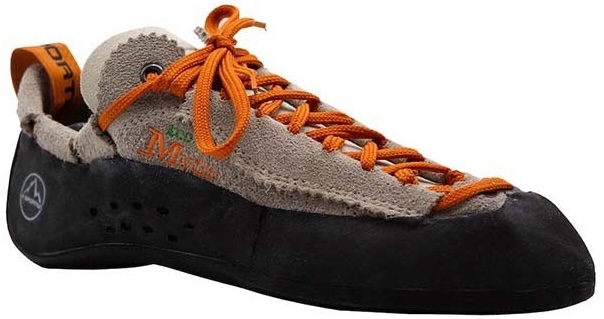 Upper: Leather
Upper: Leather
Closure: Lace
Ability level: Beginner to intermediate
What we like: Durable and incredibly well made.
What we don't: Pricey; not good for steep bouldering or face climbing.
It shouldn’t come as a surprise that the La Sportiva Mythos Eco makes an appearance near the top of this list. Many beginner-oriented climbing shoes are very obviously built with novices in mind, and all too often this means reduced craftsmanship and lower-quality materials to increase the bottom line. The Mythos, however, prioritizes quality. At the time of its release, it was a top shoe for trad climbers, and since then, it has become a dependable shoe for those new to the sport. And it doesn’t hurt that the Mythos Eco’s high-quality build is now constructed with 95%-recycled materials.
The Mythos’s success as a beginner shoe stems from its versatility on different kinds of terrain. As a climbing novice, you likely don’t know yet whether you prefer cracks or face, boulders or roped climbing. Getting an all-rounder like the Mythos is the best way to hedge your bets and be covered in most scenarios. Whereas many beginner shoes are made with the gym in mind, the Mythos is built to withstand the rigors of outdoor climbing: Even after shoving it relentlessly into cracks, the stitching stays strong, and the leather remains superbly comfortable and durable. We have found the Eco rubber slightly lacking in grip for smearing on volumes and gym walls, however. For primarily indoor use, we prefer the softer rubber of the Unparallel Up Mocc or Scarpa Veloce below, though both of those shoes lack the versatility and long-term durability of the Mythos.
See the Men's La Sportiva Mythos Eco See the Women's La Sportiva Mythos Eco
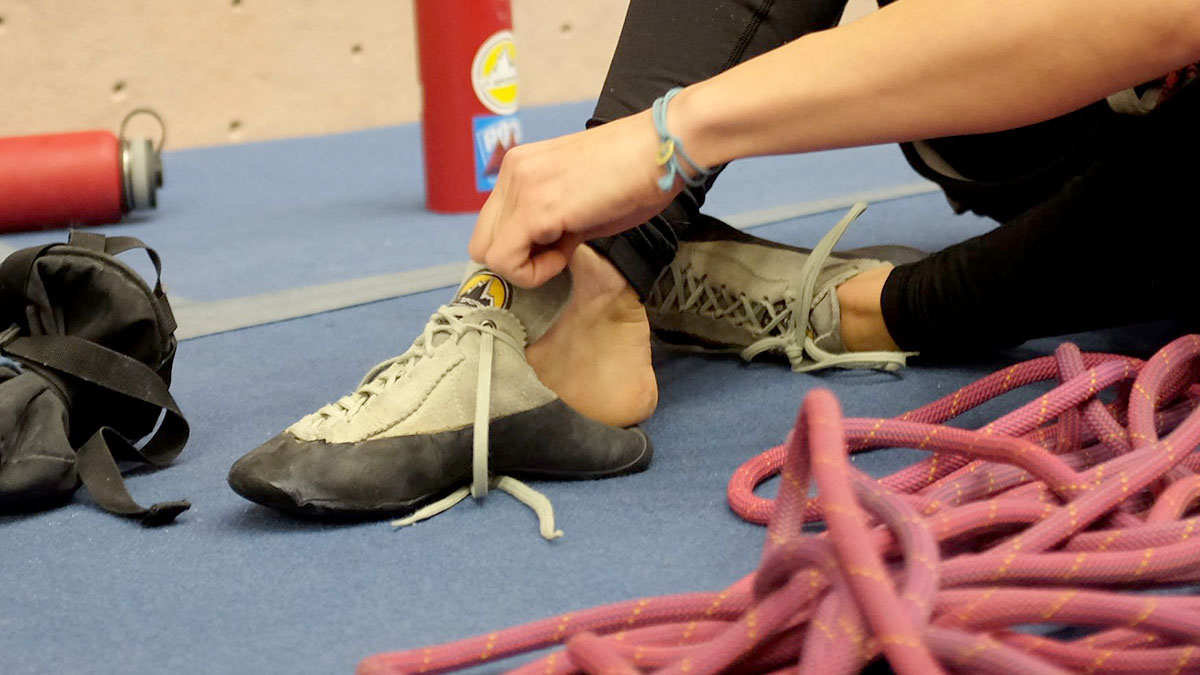
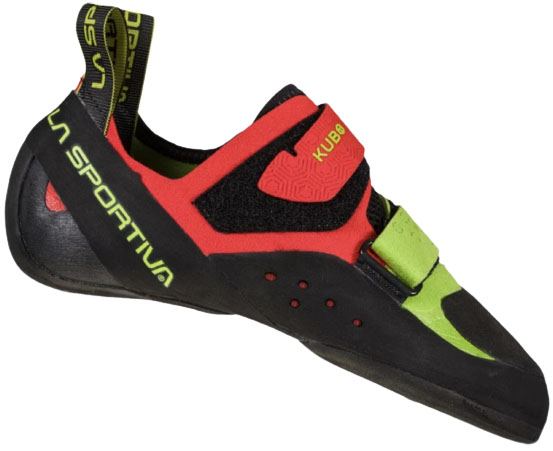 Upper: Leather/synthetic
Upper: Leather/synthetic
Closure: Velcro
Ability level: Beginner to intermediate
What we like: A comfortable design with the addition of toe rubber and a premium Vibram outsole.
What we don’t: Pricier than many true beginner offerings.
Many new climbers start out in the gym, whether out of convenience or simply wanting to learn in a more controlled environment where assistance is readily available. For pulling on plastic, La Sportiva’s Kubo stands out as a highly capable and surprisingly versatile choice from one of the best shoe manufacturers in climbing. It follows the same formula as many entry-level shoes here, with a roomy toe box, an unlined leather upper, a two-strap closure, and a padded tongue (with a breathable cotton liner). But the Kubo offers a slight level up from a true beginner shoe thanks to its slight downturn and asymmetric toe, along with the large patch of toe rubber that offers extra grip and durability for toe hooking. It all adds up to a solid all-around choice for indoor climbers who are ready to level up from a shoe like the Endeavor or Tarantula above.
You can learn a lot about a climbing shoe by looking at its rubber, and the Kubo’s Vibram XS Edge (or XS Grip 2 for the women’s version) hints at its intermediate performance slant. These are high-quality rubber blends used on the best shoes in the game and will give mid-level climbers the tools they need to improve their footwork and gain confidence on the sharp end. We also appreciate the choice between the firmer and more durable XS Edge and the softer and stickier XS Grip 2, which gives you the opportunity to cater your shoe to your body type and/or climbing style (don't get too caught up in the men's and women's designations). All told, the Kubo is an excellent modern option that won’t hold you back, and the good news is it still costs less than most of the high-end competition.
See the Men's La Sportiva Kubo See the Women's La Sportiva Kubo
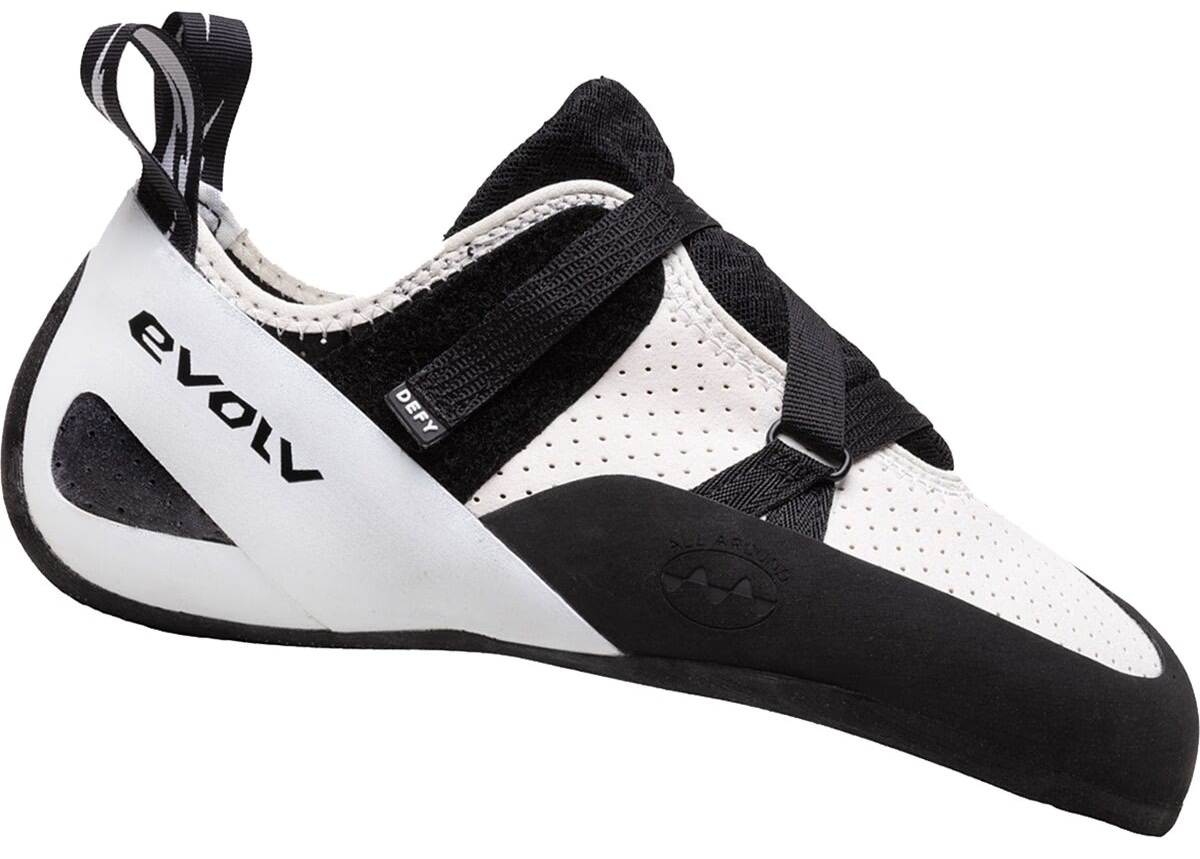 Upper: Synthetic
Upper: Synthetic
Closure: Velcro
Ability level: Beginner
What we like: A durable, time-tested classic that’s great for steep climbing.
What we don’t: Newest version might not be as comfortable out of the box; a stiffer shoe will be better for all-day wear.
Evolv is the embodiment of “slow and steady wins the race.” While they don’t often knock it out of the park, they do quietly and consistently churn out good shoes. If you’re looking for contenders at reasonable prices (compared to top models from La Sportiva and Scarpa), Evolv’s shoes might be the answer, and the Defy here is no exception. The newest version—billed as the “most advanced entry level shoe on the market”—features a touch more camber and slightly more asymmetric fit than the previous version, which was just about as flat as they come. It remains as soft and highly flexible as the prior version, making it an excellent choice for steep terrain. And there are a few other thoughtful touchpoints in this most recent update, including a split tongue for easy put-on and a perforated upper for breathability.
The latest updates to the Defy directly address our gripe with the previous model, which was that nothing about the shoe stood out. The increased downturn and slight asymmetry push these shoes closer to the ranks of the Kubo above and Veloce below without increasing the price too much. Though, we anticipate this new version to be slightly less comfortable out of the box for most folks due to these features. The newest Defy is also a unisex shoe, but we aren’t too concerned with sizing since it’s available in half sizes as well. Lastly, keep in mind that this build will tax your feet a bit more than stiffer shoes, making the Defy a better option for short sport burns and bouldering than multi-pitch climbing or all-day wear.
See the Evolv Defy
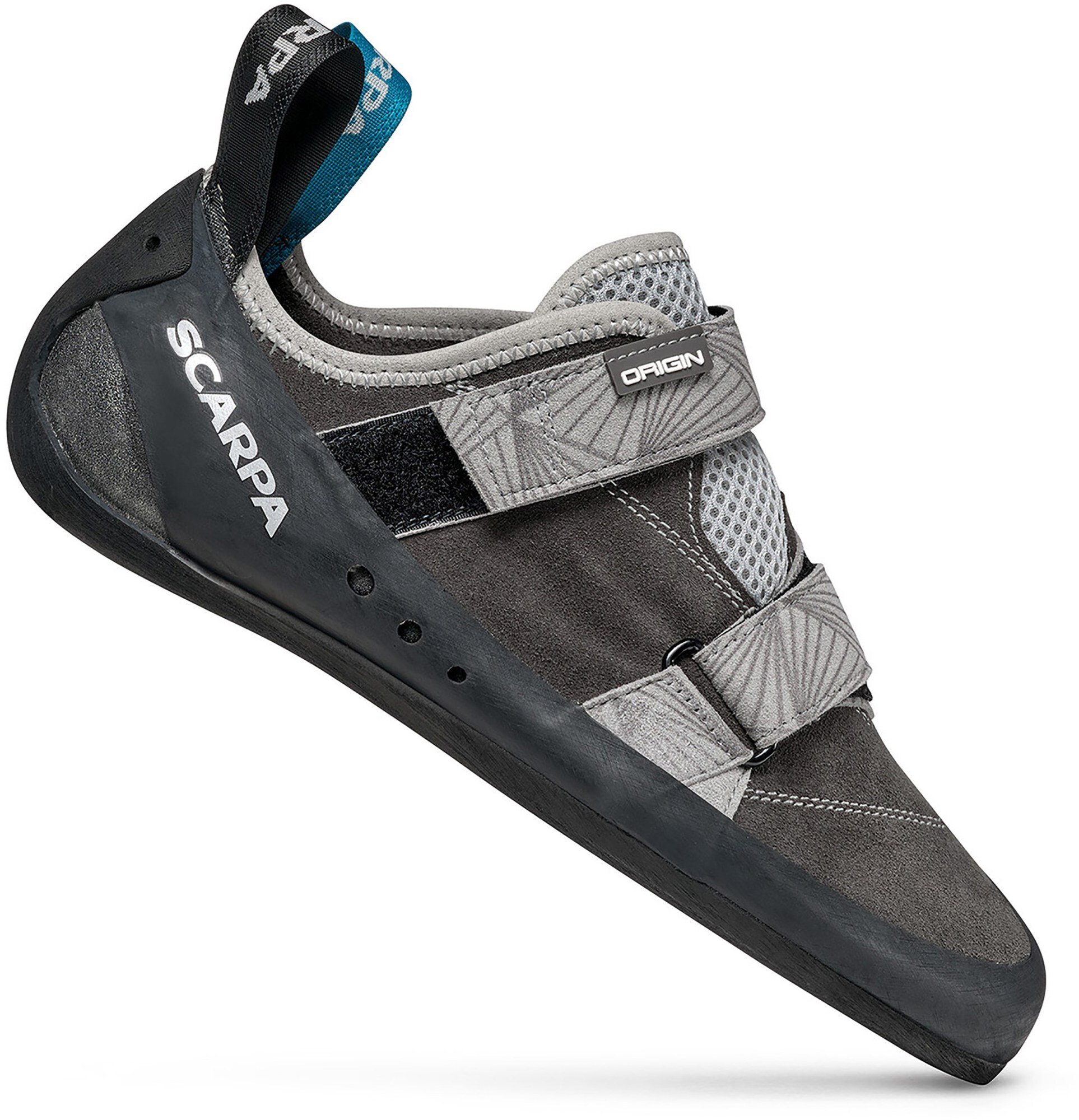 Upper: Leather
Upper: Leather
Closure: Velcro
Ability level: Beginner to intermediate
What we like: Extremely comfortable and well-thought-out design.
What we don’t: Neutral last might hold back more intermediate climbers
Scarpa’s legendary designer Heinz Mariacher, the brains behind uber-high-performing shoes like the Drago, doesn’t stop at elite. In an effort to encourage more and more folks to start climbing, Mariacher set out to design the perfect beginner shoe. Enter the Scarpa Origin. Its superior comfort is immediately noticeable, and the padded tongue gives the shoe a pillow-like feel. And while the last is flat, the sole is stiff enough to provide decent support. What’s more, the latest update improved upon fit and comfort with a retooled fit at the widest part of the foot and Scarpa’s PAF (short for Pressure Absorbing Fit) system to reduce Achilles strain. Needless to say, we appreciate Scarpa’s thoughtful and intentional approach to really nailing the details.
The Origin is essentially Scarpa’s answer to the Evolv Defy above, one of the world’s best-selling beginner climbing shoes. In fact, we think the Origin is better-designed and made with higher-quality materials, although you do pay for it. But as far as performance goes, the two have very different strong suits: Whereas the Defy is great for gym climbing and outdoor bouldering, the Origin’s stable sole and cushioned upper make it a better fit for high-mileage and multi-pitch days (the generous 5mm outsole helps). However, when it comes to steep or technical terrain, expect this shoe to feel clunky and imprecise.
See the Men's Scarpa Origin See the Women's Scarpa Origin
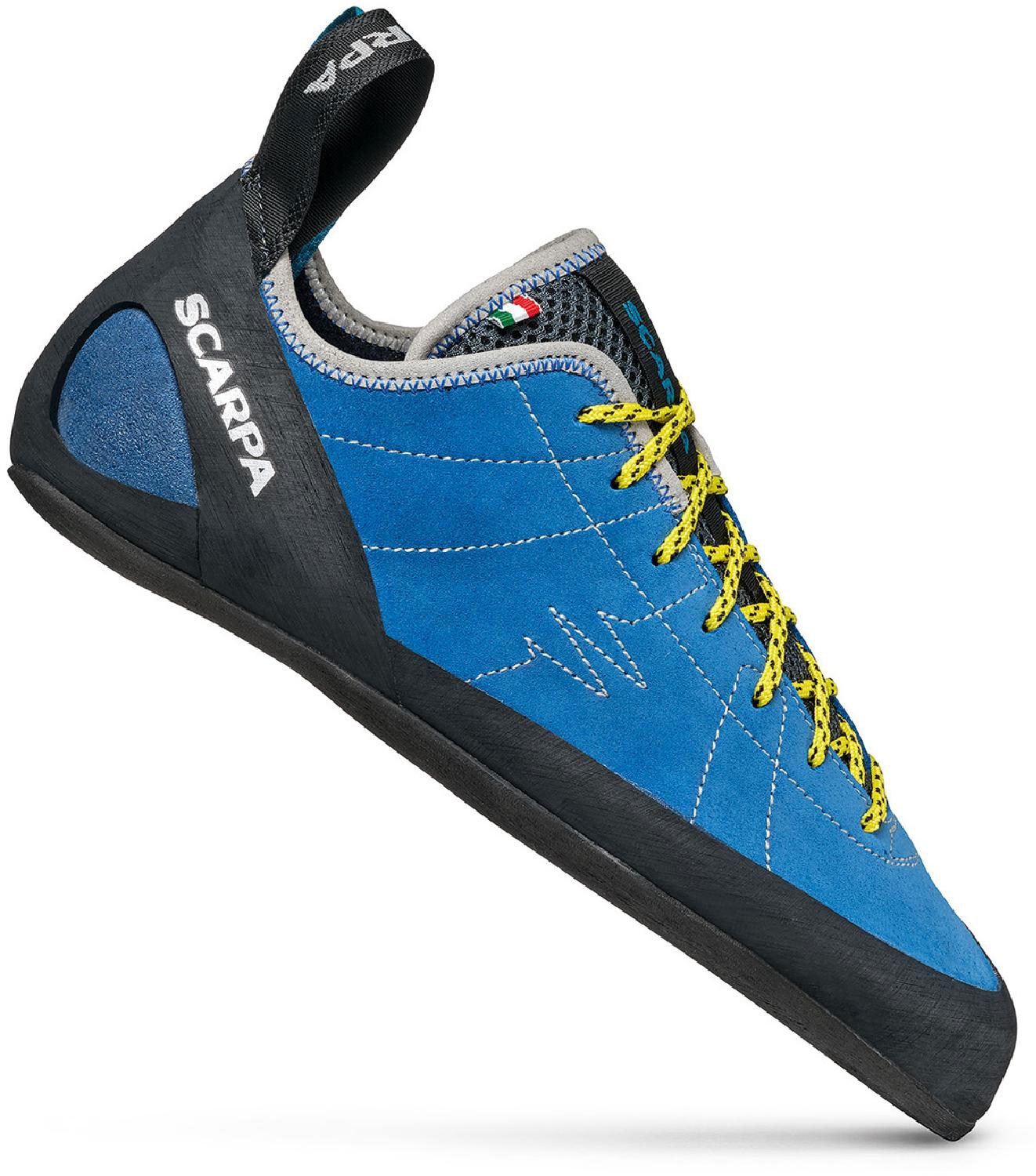 Upper: Leather
Upper: Leather
Closure: Lace
Ability level: Beginner to intermediate
What we like: Good performance shoe to help push into harder grades.
What we don’t: A bit more specialized than other entry-level shoes.
You can’t argue with Italian craftsmanship, and Scarpa shoes are almost always outstanding across the board. That said, their beginner trad shoe—the Helix—is a bit more specialized than others on this list and truly built for climbers with some experience. The good news is that many beginners progress quickly, and if you’re one of them, this shoe is a first-rate choice.
The Helix has been in Scarpa’s lineup for years, and it’s easy to see why. It perfectly blends comfort and performance for moderate-to-long alpine and trad routes (Scarpa even boasts that the Helix is a secret weapon for guides, and we believe them). The comfortable leather upper and padded tongue support all-day use, while the slightly asymmetrical fit and XS Edge rubber ensure you’ll be able to stick the tricky crux of the route. In fact, these shoes could go head-to-head with the Mythos above in almost every category—although we think La Sportiva’s beginner trad shoe offers a more customizable fit for a variety of foot sizes, earning it the higher spot on our list.
See the Men's Scarpa Helix See the Women's Scarpa Helix
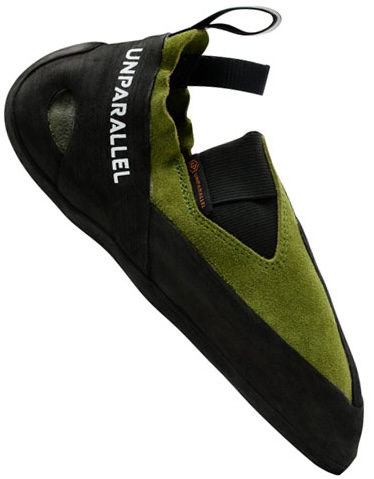 Upper: Leather
Upper: Leather
Closure: Slip-on
Ability level: Beginner to advanced
What we like: Easy on/off, sock-like fit once broken in, and very sticky rubber.
What we don’t: Tough to dial in a good fit; comes with some inherent performance drawbacks.
While still relatively new to the scene, California-based Unparallel has a storied history: Following Adidas’ acquisition of longtime climbing shoe brand Five Ten in 2011, former Five Ten designer Sang Lee founded Unparallel in 2017 to continue and improve upon Five Ten’s legacy (fun fact: They even took over the manufacturing facility). Unparallel’s Up Mocc is an intriguing option for beginners: While unlined and quite stiff out of the box, the shoes’ flat last and easy on/off make it approachable for those just starting out, and the leather upper provides a sock-like fit once worn in (note: It does take considerable time to break the shoes in). We also like Unparallel’s RH rubber, which is soft but durable and incredibly sticky (similar to Five Ten’s beloved Stealth C4 compound).
All that said, slippers like the Up Mocc have some inherent downsides. First is the lack of closure, which makes the shoes tough to fit: If you go too big, you risk sloppy footwork, while downsizing will result in an uncomfortable break-in period but a closer, more precise fit in the long run. It doesn't help that Unparallel shoes are generally hard to track down in person, and we've been unimpressed by their customer service (don't expect returns to be easy). Further, the Up Mocc isn’t the best option for overhanging climbs due to its flat last—although it’s soft enough to toe in on edges and pull your hips into the wall—and the lack of straps makes it difficult to heel or toe hook without coming out of the shoe. But again, the Up Mocc’s appeal lies in its versatility: It can edge, smear, and jam with the best of them, and you shouldn't need to upgrade anytime soon. If you don’t mind taking some time and doing your research to dial in the right fit, the Up Mocc is a true standout with a loyal following of crack climbers and boulderers alike.
See the Unparallel Up Mocc
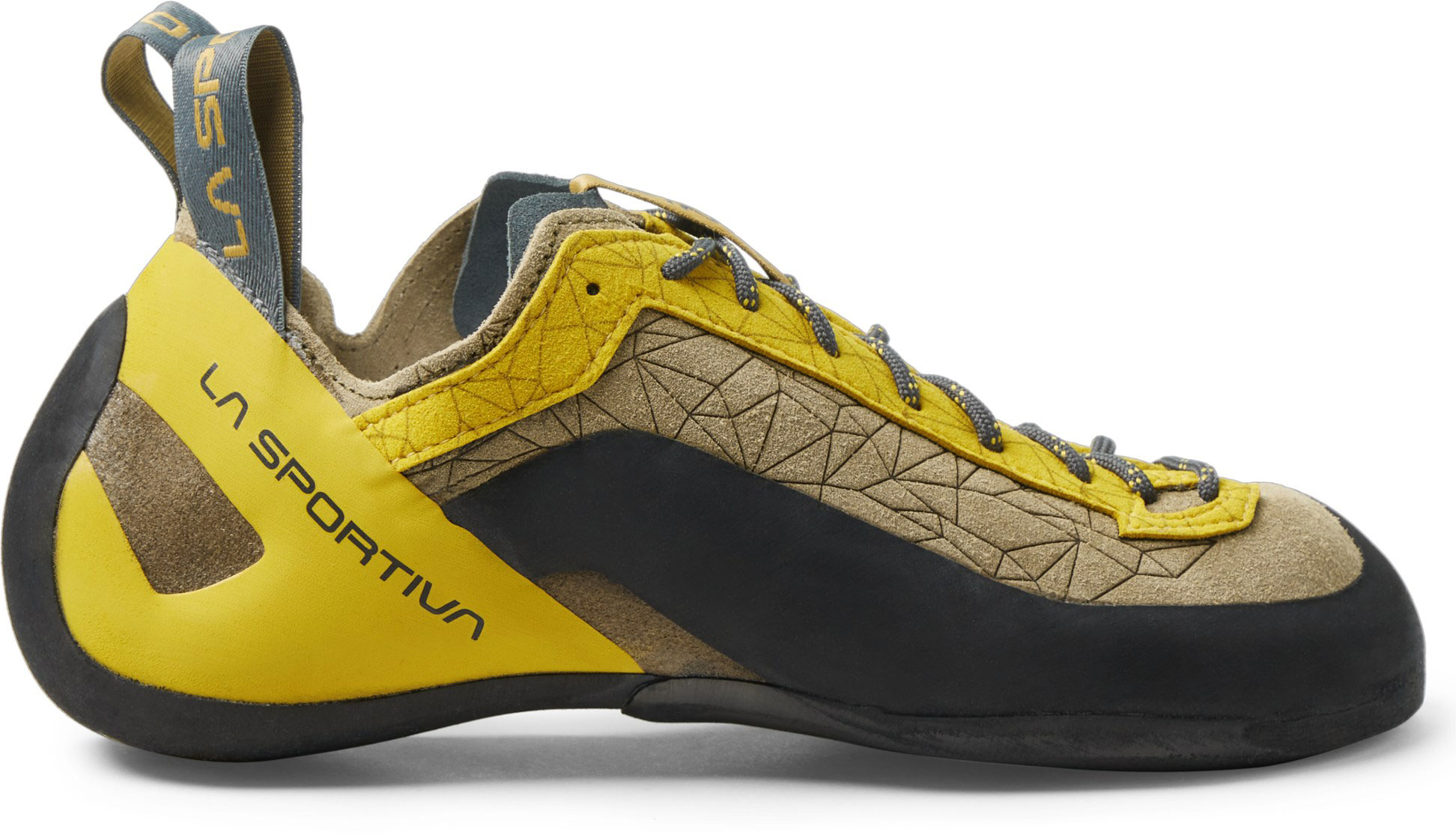 Upper: Leather/synthetic
Upper: Leather/synthetic
Closure: Lace
Ability level: Beginner to intermediate
What we like: Durable; great support for all-day trad climbs.
What we don’t: Stiffer than the Helix above.
The Finale is an entry-level climbing shoe with some features that will help you start to get a feel for what a more high-performance shoe might be like. Like La Sportiva’s top models, this shoe sports Vibram's stiff XS Edge rubber, a padded mesh tongue, a tensioned heel rand, and the company’s proprietary P3 system that holds the downturn of the shoe over time. However, given the Finale’s unlined construction (great for out-of-the-box comfort) and durable 5-millimeter sole, it’s not lost on us that this shoe is tailored toward new climbers.
The Finale goes head-to-head with Scarpa’s Helix above, and while both are great options for new trad climbers, there are a few key differences. First off, the Finale can handle a lot more wear and tear, with 5 millimeters of rubber on the sole compared to the Helix’s 3.5 millimeters. This also plays a big part in performance: The Scarpa is relatively soft and sensitive, while the La Sportiva will feel stiffer, especially during the break-in period. In the end, your final decision will come down to personal preference—some climbers love a supple and responsive trad shoe, while others prefer more structure and support. Lastly, the Finale's most recent revamp included updated aesthetics and a reduced environmental impact (40% of the shoe is now built with recycled materials).
See the Men's La Sportiva Finale See the Women's La Sportiva Finale
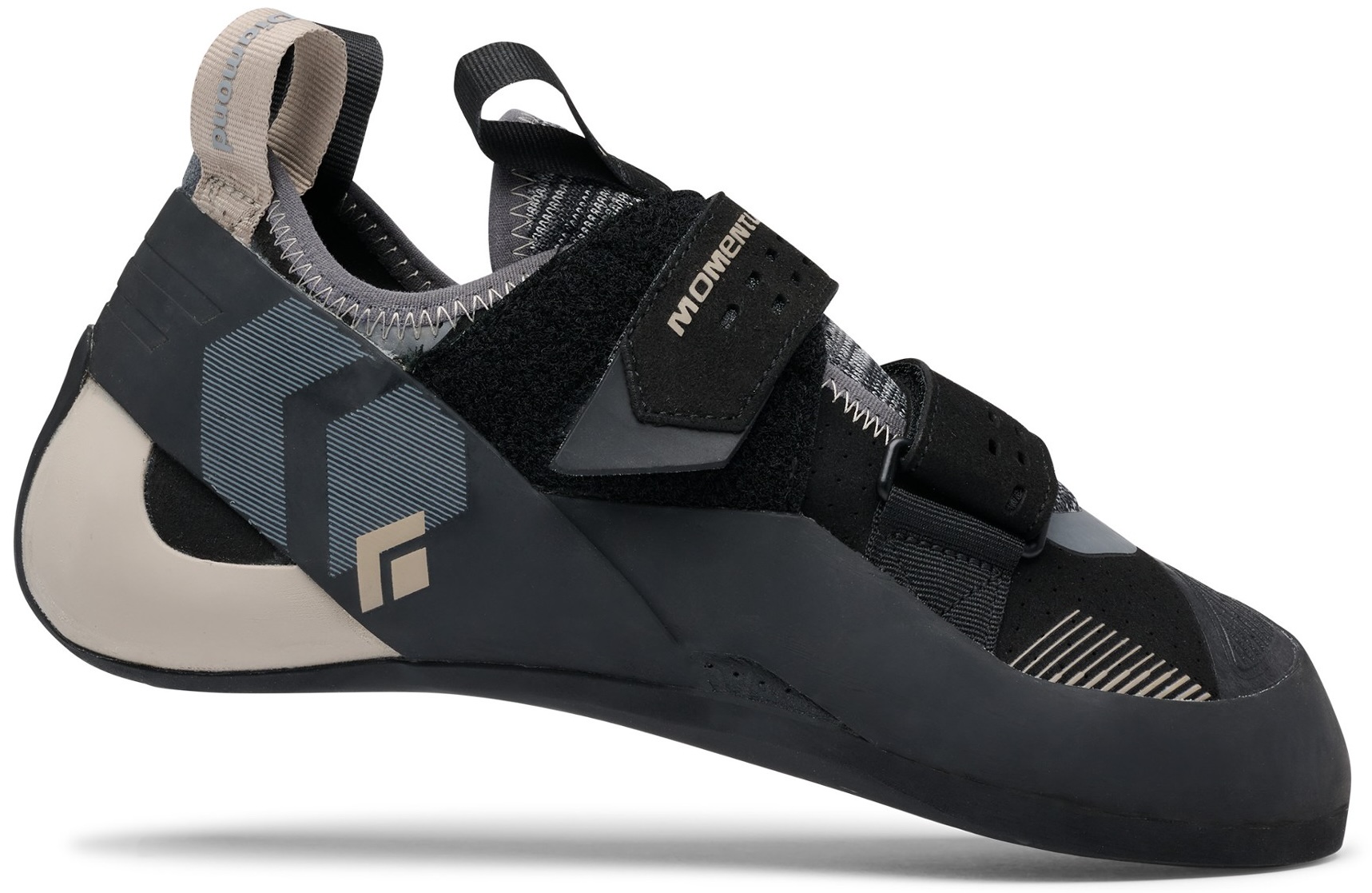 Upper: Synthetic
Upper: Synthetic
Closure: Velcro
Ability level: Beginner
What we like: Breathable knit upper and durable outsole.
What we don’t: You’ll have to spend up for comfort on the top of the foot.
Based in Salt Lake City, Black Diamond is a leader and innovator in climbing gear, including a range of popular harnesses, helmets, quickdraws, climbing shoes, and more. The Momentum here is their flat, entry-level design similar to the Scarpa Origin and Evolv Defy above but with a few important differences that make it a laudable choice for the gym. Most notably, the stretchy knit upper breathes well in sweaty indoor environments, and the 4.3-millimeter rubber is a durable choice for the high-volume nature of indoor climbing. And Black Diamond continues to hone the design: The latest version features a knit and microsuede upper, as well as an updated Velcro closure that addresses our discomfort issue with the previous version.
The updated version (which is only available through REI at the time of publishing) is a bit costlier than the previous version, which can still be purchased through Black Diamond's site. In our experience, the previous version had issues with the fabric bunching up under the straps, resulting in pesky pressure points on top of the foot. If you don’t want to spend up for the updated model, the old lace-up version is a viable alternative. And regardless of model, the flat last and roomy toe box may hold you back from progressing like you might in a more downturned, asymmetric shoe like the Scarpa Force below.
Read more: Black Diamond Momentum review (women's previous version)
See the Men's Black Diamond Momentum See the Women's Black Diamond Momentum
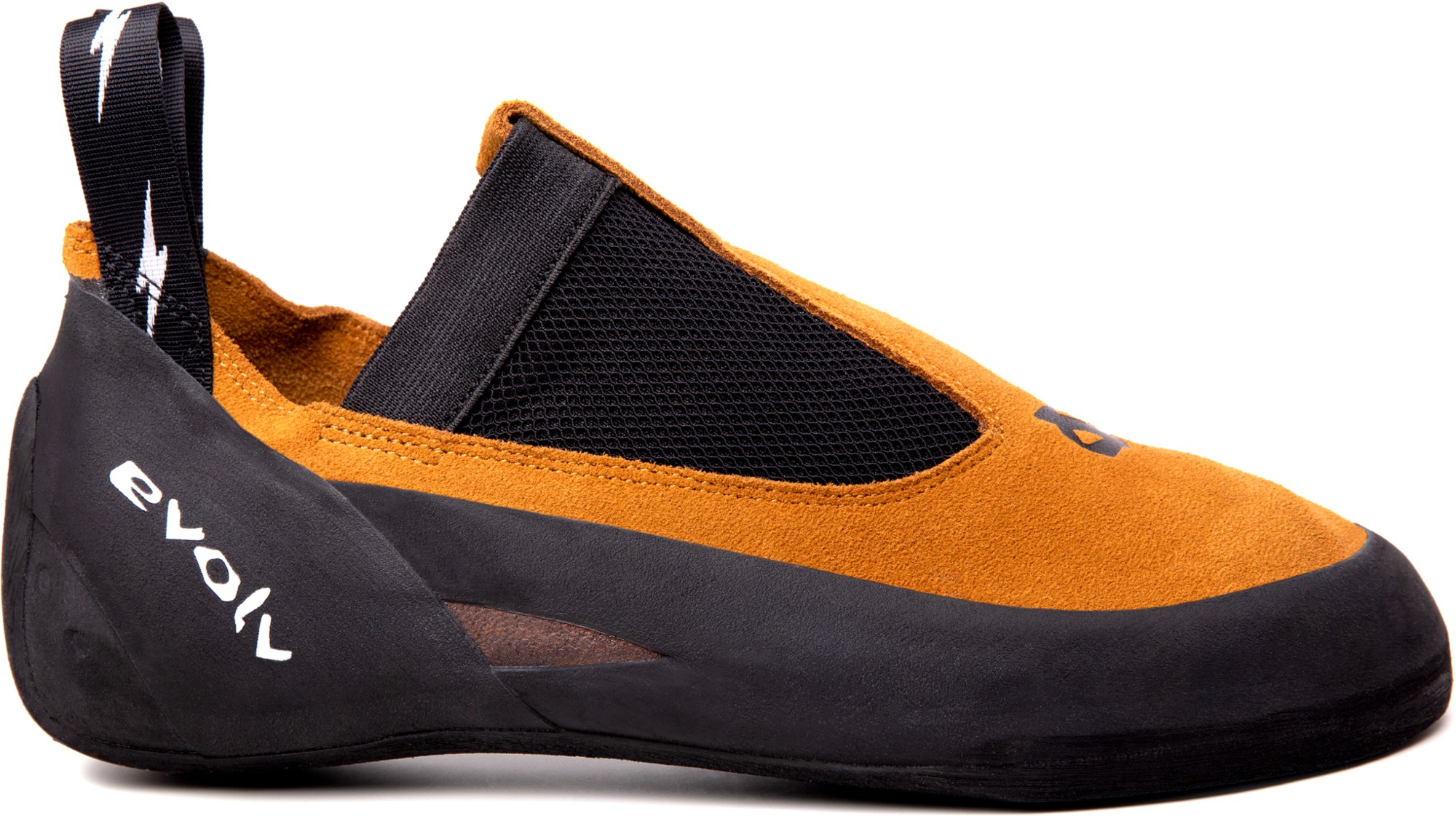 Upper: Synthetic
Upper: Synthetic
Closure: Slip-on
Ability level: Beginner to intermediate
What we like: Another great slip-on shoe with more heel tension than the UpMocc.
What we don't: More expensive than and not as grippy as the UpMocc.
Evolv’s Rave shoe is another one of our favorite slip ons. It shares many of the same characteristics as the UpMocc above, including a flat last and leather upper that conforms to the foot over time. Though, the Rave has a few advantages over the UpMocc, including a snugger heel fit and stiffer midsole, which offers a bit more support on longer routes. While the Rave still isn’t the best choice for navigating techy sport routes with small holds, their narrow toe box makes them a capable shoe for thin cracks (it's Steph Davis’s shoe of choice for Indian Creek splitters). And lastly, its easy-on, easy-off build makes the Rave right at home at the bouldering gym, too.
The most obvious downside to the Rave is price, which is a touch more than the UpMoccs above. We also prefer the UpMocc’s rubber, which is a bit stickier than the Rave’s. And there are all the classic downsides of opting for a slip-on shoe over a Velcro or lace closure, including tricky sizing. Thankfully, the Raves are a bit easier to find in person than the UpMoccs, so you’ll have a better chance at trying them on before buying. Beginner crack climbers will also likely benefit from a bit more padding in the forefoot—the unlined leather of the Rave is comfortable and breathable, but doesn’t offer much protection for toe jams.
See the Evolv Rave
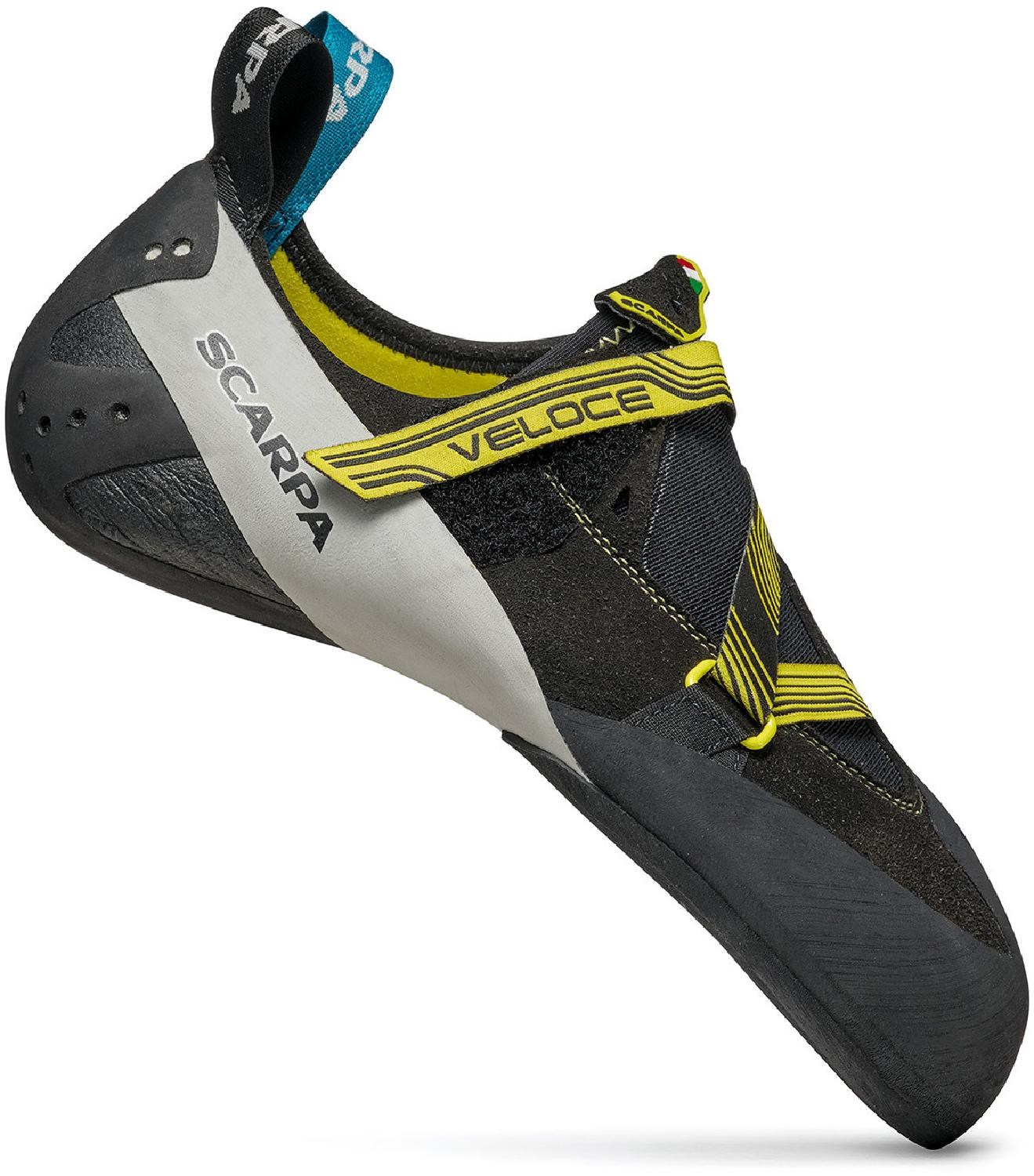 Upper: Synthetic
Upper: Synthetic
Closure: Velcro
Ability level: Beginner to intermediate
What we like: A high-performance beginner shoe for the gym.
What we don't: Expensive and not all that versatile.
In years past, beginners typically cut their teeth on low-angle slabs outside, where flat and stiff shoes like the Endeavor and Origin above shine. But with more and more climbers getting their first taste of the sport on indoor walls (read: steeper routes with bigger holds), there’s a new demand for softer and more downturned beginner kicks. The Veloce is Scarpa’s answer, merging gym climbing precision with a comfort-focused shape, durable rubber, and a relatively affordable price tag that undercuts much of the more aggressive competition.
We love the concept of the Veloce and, given the popularity of gym climbing, expect other brands to follow Scarpa’s lead. That said, it's is still a sizable investment for many newcomers. And with a clear indoor focus and rubber that’s more sticky than long-lasting, the Veloce has limited appeal for outdoor use (its super soft build isn’t ideal for true beginners either). As an alternative, the Evolv Defy above ($109) provides a similarly soft feel but lacks the aggressive downturn for precision on overhanging terrain. Finally, it’s worth noting the lace version of the Veloce, which retails for the same price and provides a very adjustable fit.
See the Men's Scarpa Veloce See the Women's Scarpa Veloce
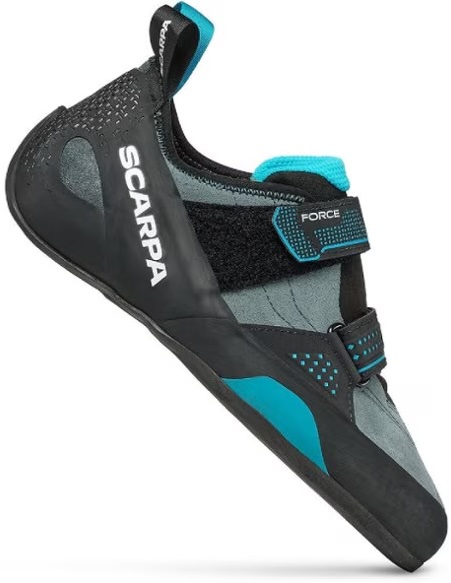 Upper: Leather
Upper: Leather
Closure: Velcro
Ability level: Beginner to advanced
What we like: High-quality construction; good all-rounder.
What we don’t: Jack of all trades but master of none.
Scarpa’s Force is yet another versatile beginner climbing shoe: It edges decently, crack climbs well, smears comfortably, and can be worn all day (even with socks). In fact, its impressive comfort has made it a popular choice for experienced trad climbers spending long days on the wall (one of our testers even wore the outgoing—but very similar—Force V on a 3,000-foot 5.11 climb in the Bugaboos and loved it). Scarpa dropped the “V” with the latest iteration, but we’re happy to report that the overall design is largely the same: Apart from a padded heel cup and the use of eco-friendlier materials, the Force remains a great option for talented newcomers and those looking to progress quickly.
Given its relatively steep price tag, the Force isn’t our first choice for true beginner climbers—consider it one of the most premium entry-level models on our list. Further, while the flat last is ideal for climbing on vertical-to-slabby terrain, it will feel clunky and imprecise on overhanging routes (check out Scarpa's own Veloce above for a downturned alternative). In the end, most new climbers will be just as happy with one of the cheaper shoes above, and if you really want to go premium, you can spend up for a shoe like the TC Pro below. But there’s certainly a market for the Cadillac of beginner shoes, and chances are you’ll notice a slight boost in performance thanks to its premium materials and construction (although we recommend dialing in your footwork before investing in pricier footwear).
See the Men's Scarpa Force See the Women's Scarpa Force
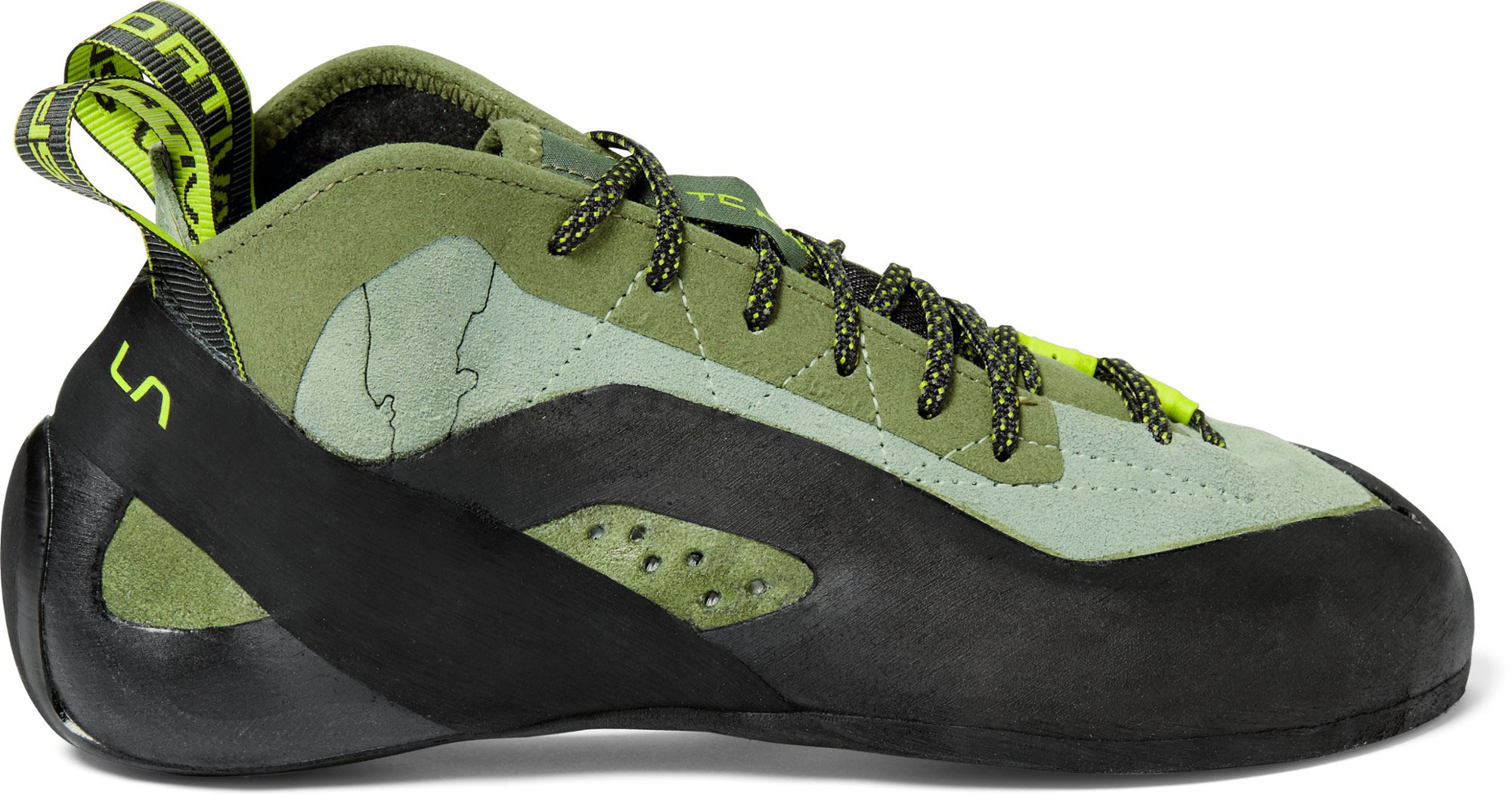 Upper: Leather
Upper: Leather
Closure: Lace
Ability level: Beginner to advanced
What we like: The best shoe for crack climbing—period.
What we don’t: Expensive and overkill for most beginners.
We’ll address the elephant in the room right up front: The La Sportiva TC Pro is decidedly not a beginner shoe. In fact, this is the shoe that Tommy Caldwell designed (hence the “TC”) and wore during his free ascent of the Dawn Wall. Heck, Alex Honnold free-soloed El Cap in it, too. The TC Pro can do just about anything on granite, from perching on tiny dime edges to gripping vertical slab. But while most beginners won’t need this level of performance for moderate routes, we recommend the TC Pro for one discipline in particular: crack climbing.
We’ve taught a lot of crack climbing clinics, and one of the most consistent obstacles for new climbers is foot pain. In short, there’s nothing natural about shoving your entire foot into a crack and then fully weighting it. And while most climbing shoes don’t offer much help with their fairly thin (and often unlined) uppers, the TC Pro features padding on the top of the foot and full ankle protection, which makes a massive difference. Although the price tag is a tough one to justify for a first shoe, if you’re stoked on cracks or are cutting your teeth in mountainous areas like Washington Pass or the Sierra, there’s simply no better option, even for newer climbers.
Read more: La Sportiva TC Pro review
See the La Sportiva TC Pro
| Shoe | Price | Upper | Closure | Rubber | Ability Level |
|---|---|---|---|---|---|
| Butora Endeavor 2.0 | $120 | Synthetic | Velcro | Neo Fuse | Beginner to intermediate |
| La Sportiva Tarantulace | $99 | Leather | Lace | FriXion RS | Beginner |
| La Sportiva Mythos Eco | $179 | Leather | Lace | Eco rubber | Beginner to intermediate |
| La Sportiva Kubo | $169 | Leather/synthetic | Velcro | Vibram XS Edge/Grip 2 | Beginner to intermediate |
| Evolv Defy | $119 | Synthetic | Velcro | Trax SAS | Beginner |
| Scarpa Origin | $129 | Leather | Velcro | Vision | Beginner to intermediate |
| Scarpa Helix | $129 | Leather | Lace | Vibram XS Edge | Beginner to intermediate |
| Unparallel Up Mocc | $126 | Leather | Slip-on | RH/VD rubber | Beginner to advanced |
| La Sportiva Finale | $139 | Leather/synthetic | Lace | Vibram XS Edge | Beginner to intermediate |
| BD Momentum | $120 | Synthetic | Velcro | In-house rubber | Beginner |
| Evolv Rave | $139 | Leather | Slip-on | Trax SAS | Beginner to advanced |
| Scarpa Veloce | $179 | Synthetic | Velcro | S-72 | Beginner to intermediate |
| Scarpa Force | $189 | Synthetic | Velcro | Vibram XS Edge | Beginner to advanced |
| La Sportiva TC Pro | $239 | Leather | Lace | Vibram XS Edge | Beginner to advanced |
The truth is that we all start somewhere, and even the experienced climbing editors at Switchback Travel were beginners at one point. We’ve come full circle since our humble beginnings dialing in footwork at local gyms and low-angle crags, now focusing our efforts on objectives like multi-pitch routes in the North Cascades and big walls in Yosemite. Former senior editor Jenny Abegg began climbing at a young age and fine-tuned her technique on rugged granite peaks in Washington state. This list of beginner climbing shoes began in 2015 with four designs hand-picked by Jenny, who leveraged her extensive experience testing a variety of models throughout her climbing journey. Editor Maddie Downie took over the guide in 2024. Although she grew up in the Colorado foothills, Maddie didn't start climbing until her adult years but quickly developed a passion for the sport. She now works part-time as a youth coach at a local climbing gym, helping beginners gain confidence on the wall.
In selecting our 14 favorite beginner climbing shoes, we prioritized different qualities than those sought after in advanced designs. While experienced climbers typically are willing to sacrifice comfort for higher levels of performance, beginners should focus their search on shoes that are durable, affordable, and comfortable enough to wear all day. For comfort, we look for shoes that are flat-lasted and symmetrical, with leather designs being our top choice due to the fact that they stretch and conform to your foot over time better than synthetics. Durability is also crucial: We value shoes with thick midsoles and high-quality components that hold up well over time. Finally, since we know that many beginners will upgrade as they progress, we made sure to balance overall performance with affordability.
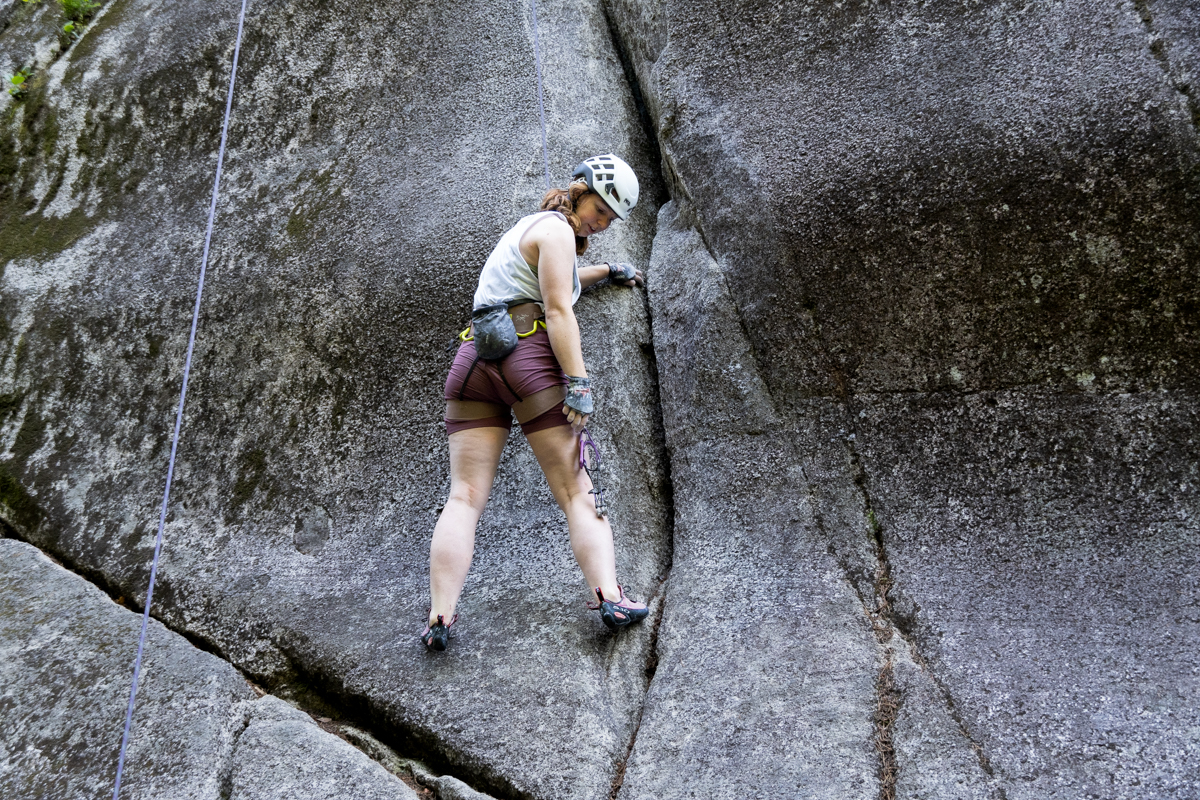
Beginner climbing shoes are easily discernible if you’re staring at a wall of all your options. To start, they’re generally flat, while more advanced shoes have at least some downturn (think a curved banana shape). The toe tends to be almost rounded and only slightly asymmetrical (if at all) compared to the more pointed toe of an aggressive shoe. And finally, beginner shoes are often less flashy—they lack many of the bells and whistles found on higher-level models.
That said, a quality starter shoe should come with a few very important features—not all of which are visible upon first glance. First is a low price tag. As a beginner, you can easily spend more than $200 on a pair of climbing shoes, but you certainly don’t need to (for more, see our section on Why Beginners Should Spend Less below). Second is a relatively durable sole. Some rubbers are softer (and thus grippier) than others, but beginner shoes are made with harder, stiffer blends to ensure they last while you’re learning how to use your feet on the wall. And the most important feature, by far: comfort. Climbing is a tough sport with a steep learning curve, and it’s a lot harder to stick with it if your feet are screaming every time you put on your shoes. Over time, you will adapt to the pain of tighter shoes, but we recommend starting with a pair that you can wear comfortably all day.
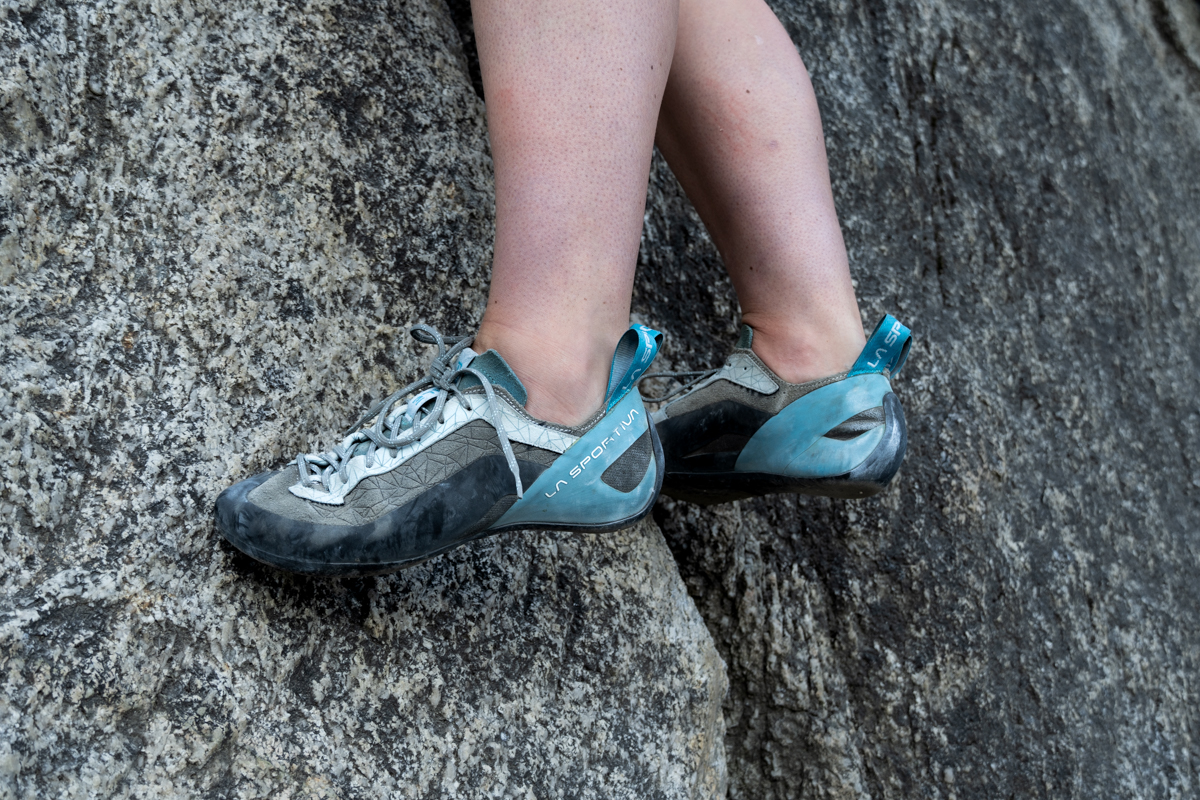
All of the shoes on this list can be worn for both gym and outdoor climbing, although many trend toward one discipline or the other. If you’re sticking mostly to the gym, you’ll probably want a Velcro closure or slip-on shoes for easy on and off and durable soles (5mm of rubber) that can take a beating—your shoes will see a lot more mileage in the gym than outside. On the flip side, indoor routes tend to be significantly steeper than lower-grade climbs on real rock, so soft shoes with a good amount of flex and sensitivity (like the Evolv Defy) can be helpful, especially if you favor bouldering over roped climbing.
Those cutting their teeth outside will likely want to bump up to a higher-performance shoe. You might not think twice on a gym 5.7, but climbing on real rock is a whole different ballgame. Having a little more confidence in your footwear when there are greater consequences (like a ground fall) can help considerably. Look for high-quality rubber blends like Vibram’s XS Grip 2 and XS Edge, and if you plan to stick your feet in cracks (as is common in trad climbing), a lace-up shoe is a good idea. Finally, because you’ll likely start on slabs rather than overhanging terrain, we recommend a stiffer shoe with good edging capabilities, like the Scarpa Force or La Sportiva Finale. For more information on the various features important to climbing shoes, continue reading our breakdown below.
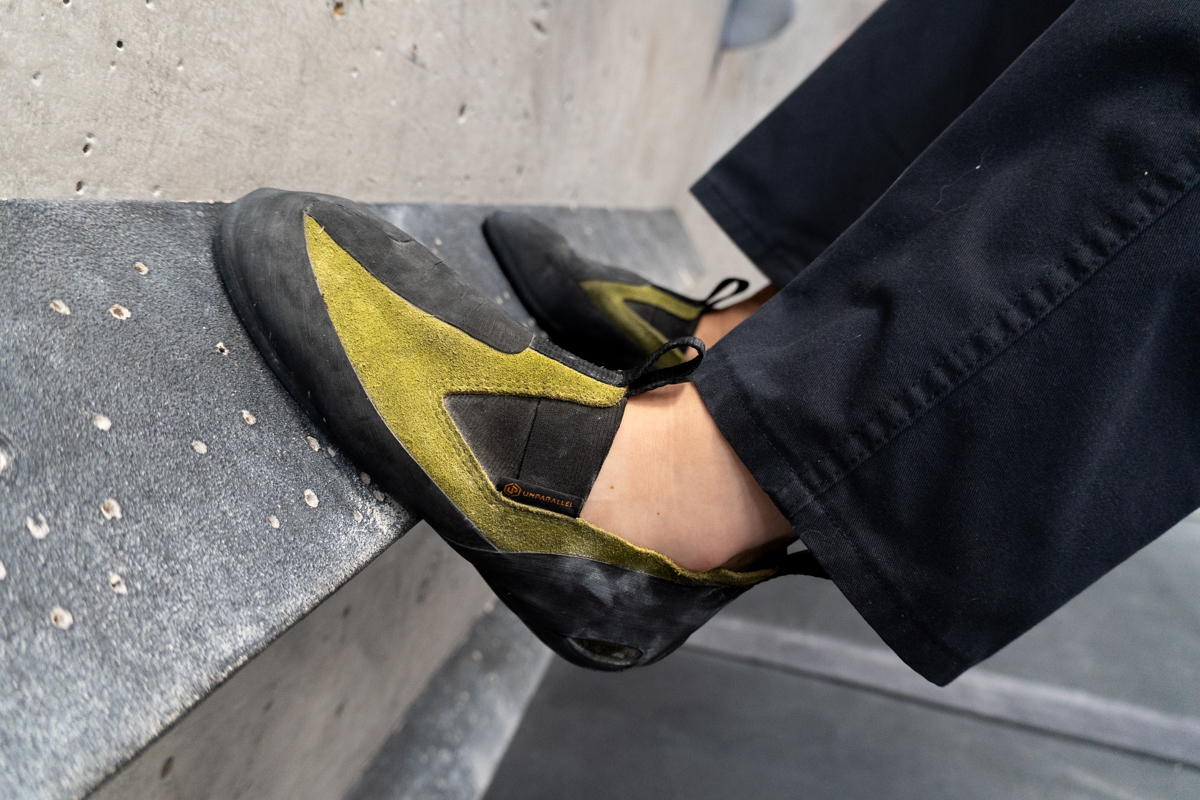
It can be confusing to understand the often-subtle differences between materials in outdoor gear, but in this case, there’s a golden rule: Leather stretches, but synthetic doesn’t. While there are a couple of exceptions (leather is sometimes lined, which prevents it from stretching quite as much), this rule will hold true for almost all climbing shoes.
For beginners, both leather and synthetic can be good choices, but it’s important to consider the implications. If you choose an unlined leather shoe like the La Sportiva Mythos, expect it to stretch a whole size over time. That means you’ll have to size it small from the get-go and face a potentially painful break-in period. If you go with a synthetic option like the Evolv Defy, expect the shoe to stay true to size. While this might sound (and feel) like a good thing at first, the initial benefits quickly wear off, while leather conforms to the shape of your foot to eventually provide superior comfort. If we were to make a recommendation, we’d tell you to stick it out and go with leather. It tends to be more durable and comfortable over time, both of which are important considerations for beginners.
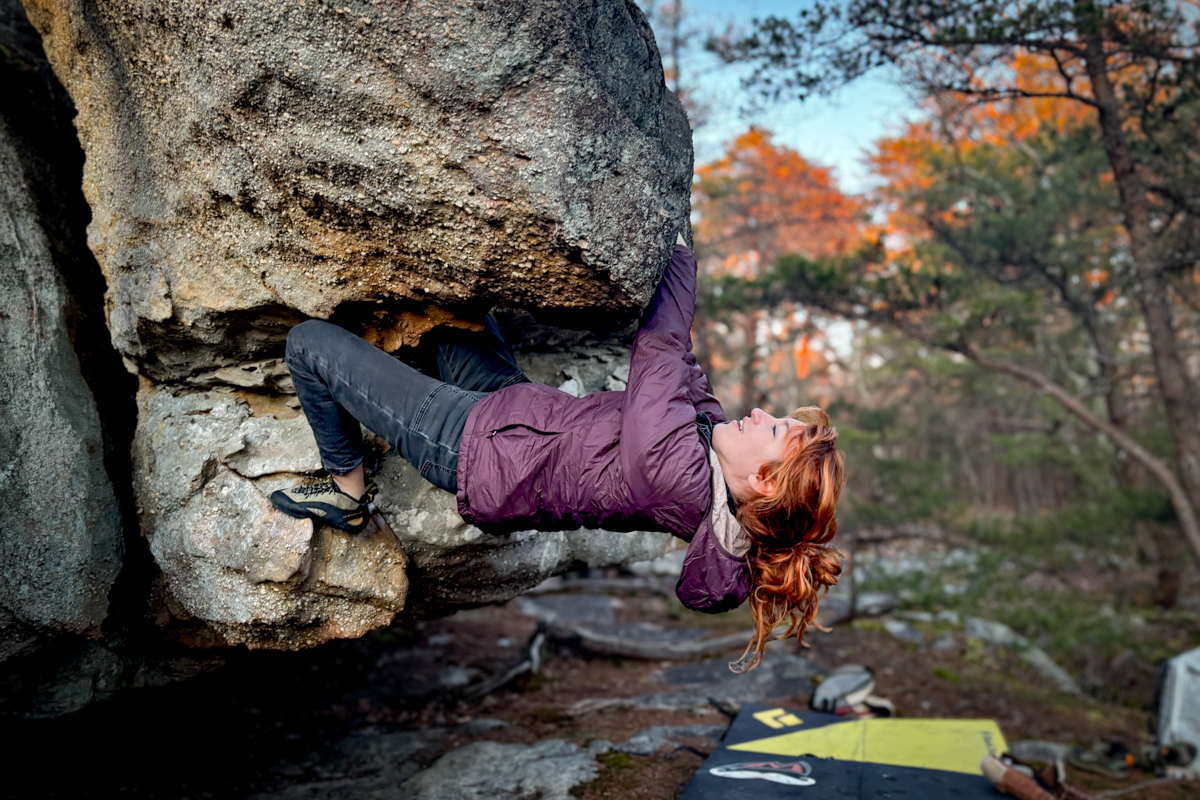
There are three main types of closure systems for climbing shoes: lace, Velcro, and slip-on. Since there’s no unanimously superior closure type for beginner shoes, we’ll let you make the final decision. Below, we break down the pros and cons of each. And keep in mind that many of the shoes in this article are available in both lace-up and Velcro versions—if you like the sounds of a shoe but prefer a different closure system, you may be in luck.
Lace
Laces are helpful for novice climbers because you can tailor the comfort-to-performance ratio specifically to your level of climbing. In other words, you can adjust the tightness and fit of the shoe around your foot depending on how you want it to perform. At first, you’ll probably find comfort more important, but over time, you’ll likely care more about performance. Laces give you the versatility to tighten or loosen your shoes accordingly. That said, laces can quickly become a pain if you’re putting on and taking off your shoes repeatedly, as is the norm in the gym or while bouldering. They can also break and be difficult to replace (one of the few problems with the La Sportiva Mythos Eco). We recommend lace-up shoes if you’re primarily crack climbing outside, but for everything else, beginners should stick with Velcro or elastic closures.
.jpg)
Velcro
Velcro is incredibly practical—it’s always easy on-and-off, which is paramount for gym climbing and bouldering, both outdoors and indoors. The downside? Velcro can be somewhat limiting in how well it fits—you can only tighten or loosen as much as the material allows. It also tends to fail over time, which is a major concern we have with a shoe like the La Sportiva Tarantula. And a quick note for the crack climbers out there: If you plan on spending a lot of time wedging your way up ‘em, Velcro is not an optimal choice, as it can snag, undo mid-route, or cause painful pressure points. However, if you’re primarily bouldering or gym climbing, we absolutely recommend a Velcro shoe.
Slip-on
Slip-on climbing shoes forego Velcro or lace closures in favor of simple elastic around the top of the foot. Much like a slipper, these shoes are incredibly easy to take on and off (even more so than Velcro designs), and the low-profile shape makes them an excellent choice for jamming into cracks, too. However, there's a reason the Unparallel Up Mocc and Evolv Rave are the only slip-on shoes on our list: The absence of an adjustable closure means they often require more downsizing to achieve a proper fit, which can result in an uncomfortable break-in period. In the same vein, if the shoe is too loose, there's no way to cinch it down, leading to sloppy footwork and the risk of pulling the shoe off when heel hooking. However, if you're willing to grit through your first few sessions, slip-on shoes will improve as you do and offer a sock-like fit that other styles lack.
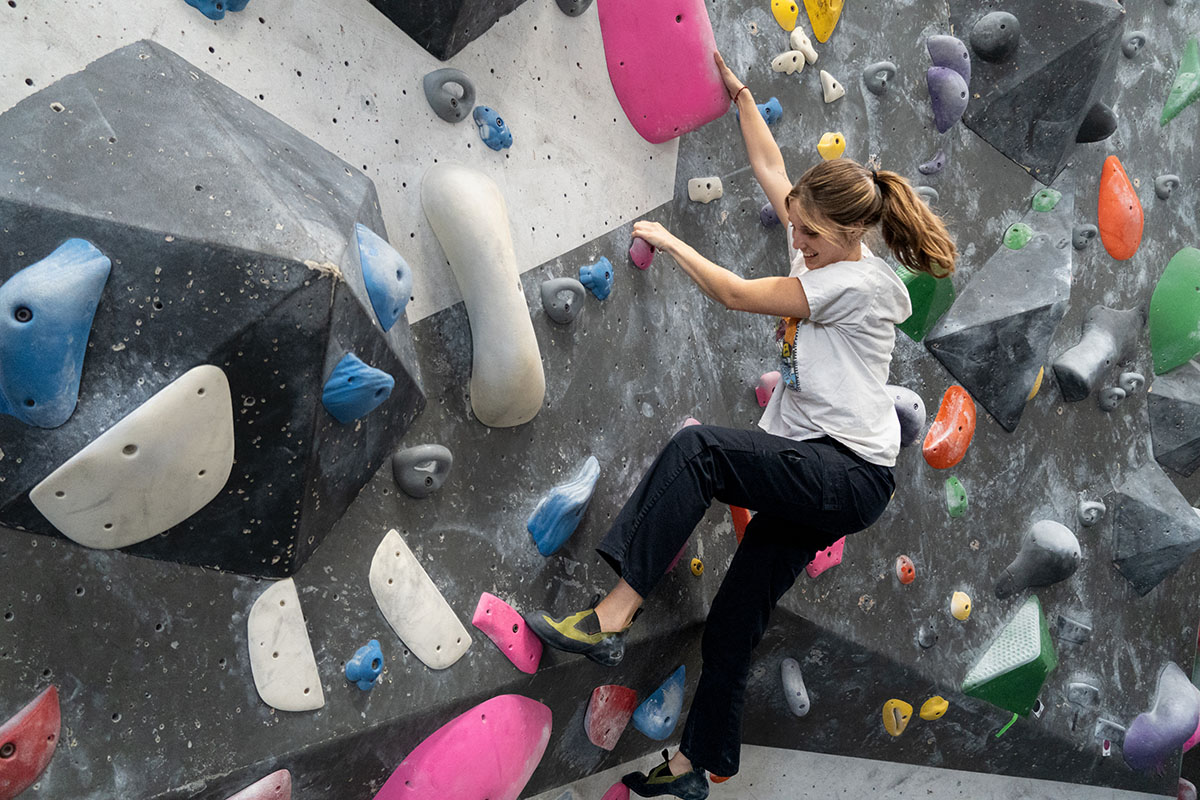
A simple way to categorize climbing shoes is by the stiffness of the midsole and sole. Climbers who gravitate toward steep boulder problems or gym climbing will likely prefer a soft shoe that allows them to flex their feet around holds. These shoes provide far greater sensitivity between rock and foot, but—as a result—your foot will have to work a lot harder than it would in a stiffer, more supportive shoe. Those who plan on climbing long routes outside will benefit from the edging, stability, and support of stiffer shoes. In general, unless you’re just bouldering at the gym, we recommend that beginner climbers wear a shoe with a moderately stiff midsole to help support their foot muscles and ligaments as they build strength.
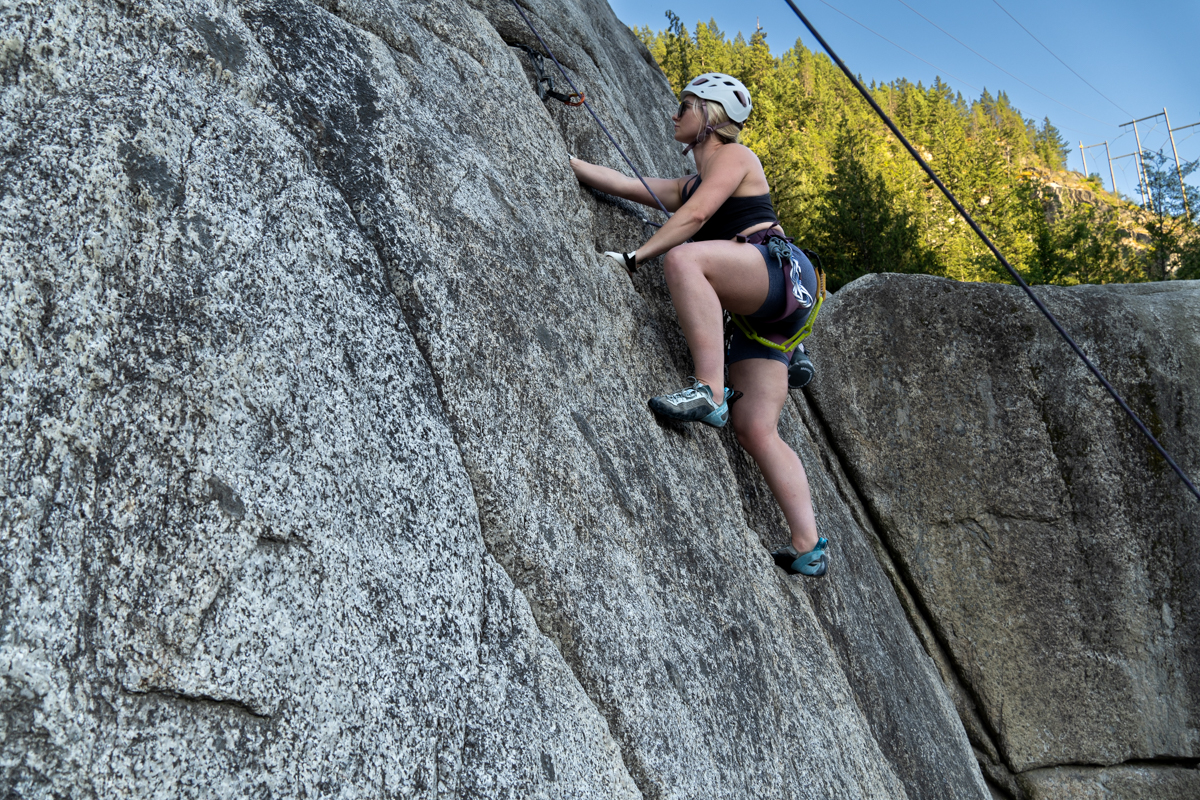
Rubber is one of the most important features of a climbing shoe. The more time you spend climbing, the more you’ll geek out about it: the different styles, thicknesses, and the perfect recipe for sending your project. But for now, we’ll keep it simple and talk about two main features: grip and durability.
Your best bet as a beginner is to get the most bang for your buck, and in terms of rubber, this means a fatter sole. Anything 4 millimeters and up is a good start—anything thinner won’t last nearly as long. But not all rubber is created equal—some blends prioritize grip, while others excel at durability. For example, Five Ten’s Stealth C4 and Vibram’s XS Edge are stickier than La Sportiva’s FriXion RS but not as durable. For true beginners, the benefits of durability will outweigh the minor differences in stickiness. But as you progress, a sole lacking in grip will actually hold you back.
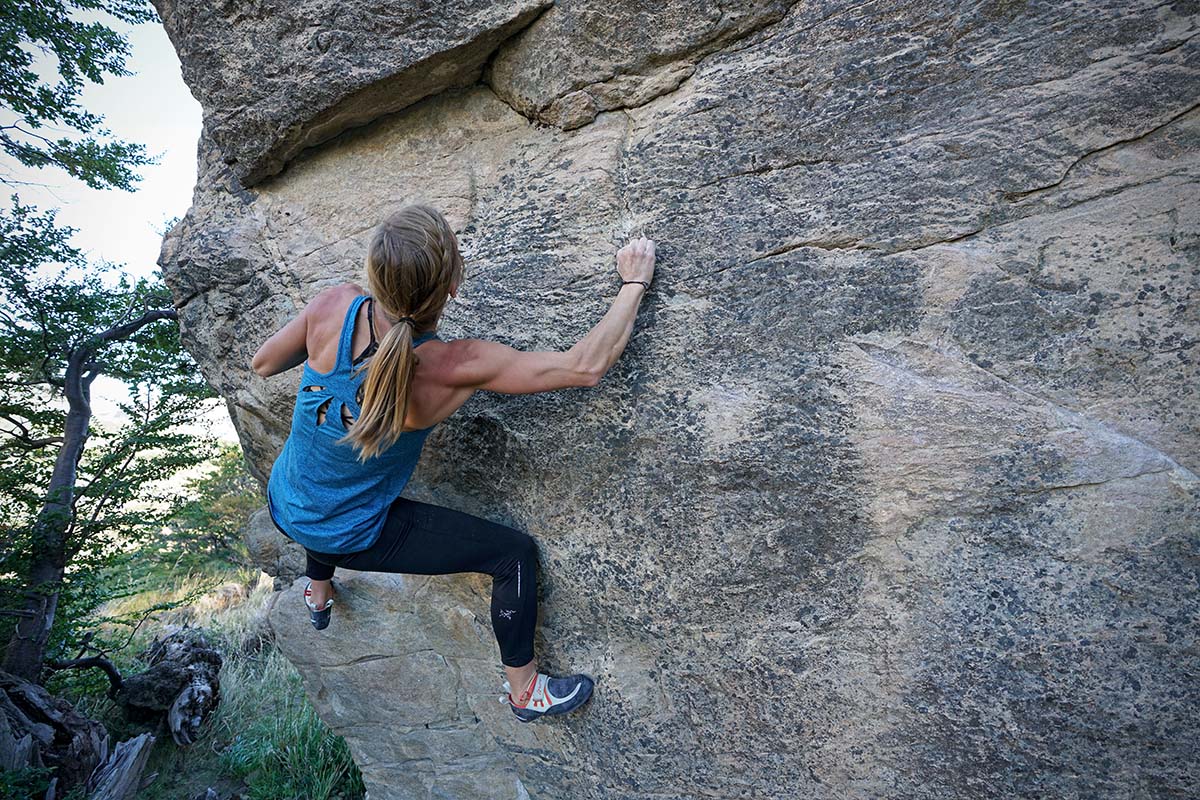
You may have been told by a friend, store clerk, or climbing gym employee that you need to buy shoes so tight they hurt your feet. We’re here to tell you the opposite. Beginner climbers need tight shoes—just like any climber does—but comfortably tight shoes. The initial investment in climbing is so great, and the learning curve so steep, that the last thing you want is to loathe the idea of climbing simply because your feet are in constant pain. Besides, the terrain and holds you’re climbing as a beginner simply don’t warrant a high-performance shoe with an uber-tight fit. It’s great to be able to stand on dime-sized edges, but most beginners realistically aren’t going to be doing that.
There’s another important lesson here: How you use your feet is more important than what you put on them. If your shoes are a little on the roomy side, it will only force you to improve your footwork. Over time, it’s best practice to get used to overcoming obstacles by working on technique rather than buying different gear. In general, get the same size you would in street shoes or a half size down. Major exceptions to this rule (like the Butora Endeavor 2.0) will typically state them explicitly. And as we mentioned above, leather will stretch more than synthetic, so size your leather shoes down a bit and expect to endure a few mildly uncomfortable break-in sessions.
Most climbing shoes are available in both men's and women's versions, with the main differences coming in terms of colorways and rubber (contrary to popular belief, there are rarely differences in fit and sizing). Although this doesn't always apply to the beginner market, it's common to see stiffer (and more durable) rubber like Vibram XS Edge on men's shoes and softer (and stickier) Vibram XS Grip 2 on women's shoes. Stiffer rubber is great for edging and slab climbing, while many sport climbers and boulderers prefer softer compounds for better grip and sensitivity.
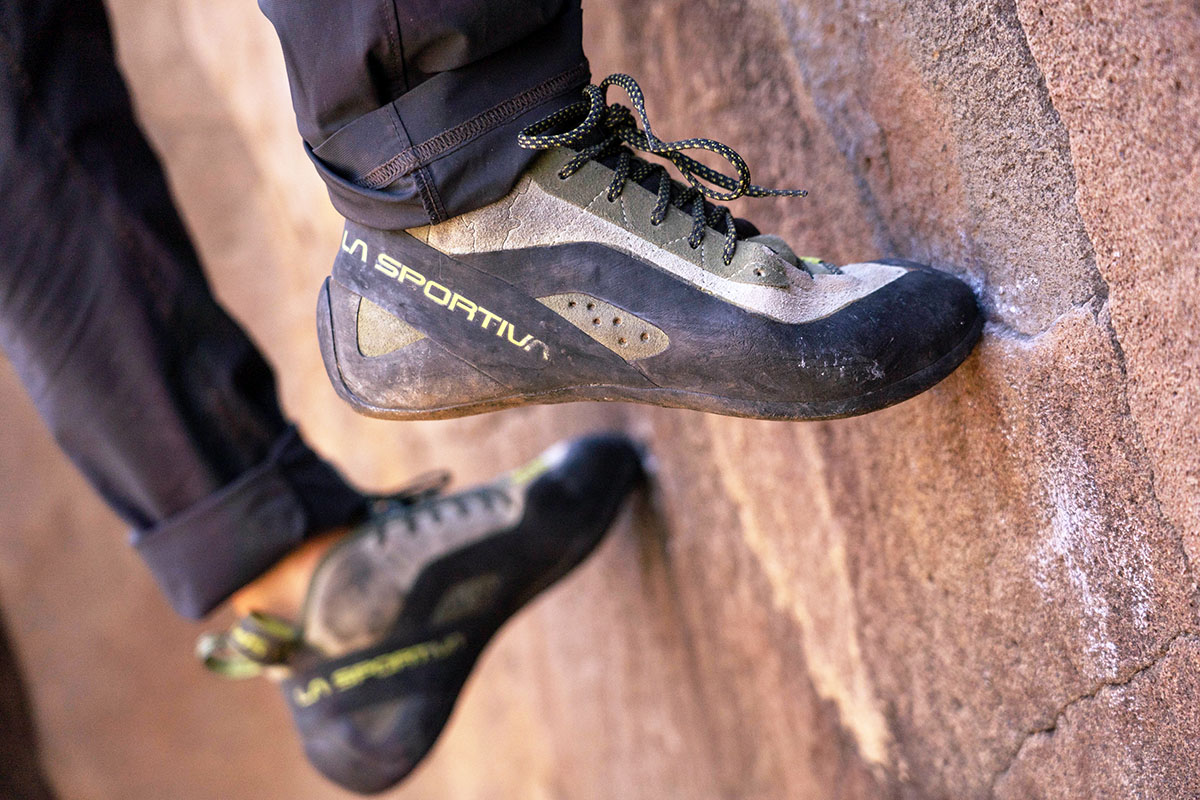
Climbers can be especially picky about their rubber choices, so it's very common to see men wearing women's shoes and vice versa. In the end, we like to think of a shoe's two models as being Option A and Option B rather than assigning them genders. Butora offers their shoes in “wide” and “narrow” rather than in men's and women's versions, and it's also common to see high-volume and low-volume fits. Finally, keep in mind that some unisex models (like the popular La Sportiva TC Pro) aren’t made in varying widths. If your foot is wider or narrower than most, it’s likely that these shoes won’t work for you.
While not quite backcountry skiing, rock climbing isn’t the cheapest outdoor sport, either. A harness will run you $60 at minimum, then add in a belay device and locking carabiner for another $50 and a gym membership for up to $130 per month. Factor in $25 for a chalk bag and $5 a month for chalk. Adds up quickly, doesn’t it? If you get into outdoor climbing, you’ll also need a rope, helmet, quickdraws, and so on (you should be hearing the sound of a cash register right about now). As a beginner, it’s all new, and it’s all a hefty investment in something you know very little about.
All that said, why break the bank on a pair of shoes? More to the point, why spend extra for features you don’t need? You’re a beginner, so don’t worry about a highly asymmetric toe, aggressive downturn, powerful slingshot rand, top-notch heel- and toe-hooking ability, or incredible edging precision. If you’re like most beginners, you probably don’t even know what half of those things mean, and you don’t need to. Your only job as a new climber is to enjoy yourself and figure out if you really want to commit to the sport. So go ahead—buy cheap. Permission granted. And if you continue to enjoy climbing, you’ll upgrade down the road.
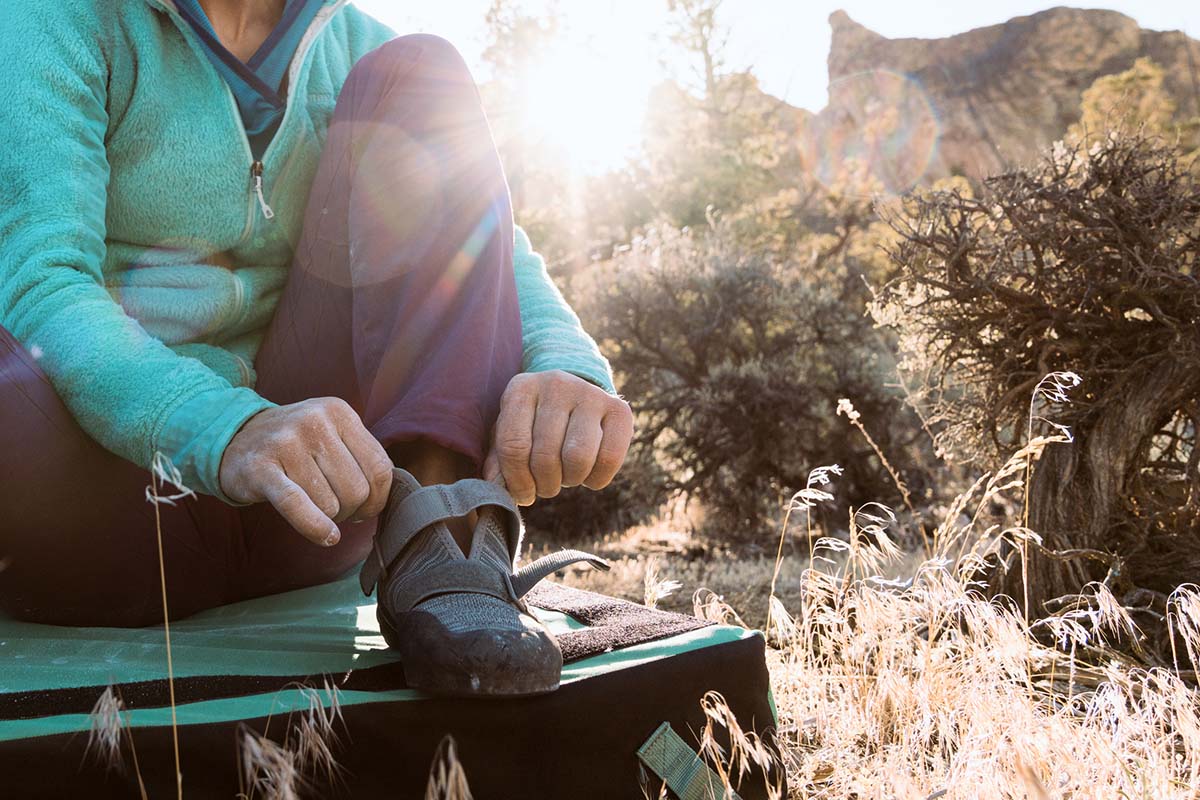
“Beginner” is a pretty broad and relative term. Some climbers are sending 5.12s and V6s after just a month of practice. They’re still beginners—just innately talented ones. If you’re one of those people, few of the shoes in this article are right for you, and you should instead consider one of our top rock climbing shoes. We’ve also included a few models on this list—including the La Sportiva TC Pro and Scarpa Force—as options that can transition with you into tougher grades. Generally speaking, they are more expensive, so only start out with these shoes if you’re hell-bent on becoming proficient, learn quickly, or climbed out of your crib before you could walk.
If you’re like the rest of us, you can expect it to take longer to break into harder grades. As you do, you’ll start to feel like your shoes are limiting you. This is when you upgrade. But remember: Don’t buy new shoes because you think they will help you progress. Buy new shoes because you have already progressed and your old shoes are holding you back. If you use your shoes as a crutch, you’ll tend to make excuses for what is really a lack of strength and technique. Conversely, if you develop the strength and technique first and turn to new shoes second, you’ll actually get the boost you’re looking for because you’ll already be adept at doing more advanced moves with less advanced shoes.
Back to Our Top Climbing Shoe Picks Back to Our Climbing Shoe Comparison Table